Jurassic spark: Is there a future in dinosaur cloning?
In the 20 years since Steven Spielberg's benchmark-setting blockbuster was released, advances in science have debunked some of the assumptions made by the filmmakers. And, while it may still be possible, palaeontologist David Hone makes no bones about the future of dinosaur cloning


Excited, I clear the sand away. After only a few minutes, I can see it is more than a fragment: it is nearly a whole bone, probably a part of a hand or foot. A few more minutes’ digging and it is clear there is more than one bone here. I shout at two members of my 15-strong team to come and help. By the afternoon there are five of us working at the site, by the next day, seven, and a couple of days later we have excavated a block of stone that is so heavy it requires almost the entire Chinese- American crew (plus one token Brit – me) to haul it out of the valley and into a 4x4. We’ve shifted hundreds of kilograms of rock, mostly by hand, under a punishing desert sun. But it has been worth it. By the end, we have removed perhaps half the skeleton of a carnivorous dinosaur.
THESE ARE THE MOMENTS palaeontologists like me live for. Such a find can radically enhance our understanding of what dinosaurs looked like and how they behaved. And, such game-changing discoveries aside, smaller research projects are constantly revising what we know about these extraordinary animals. Fifty new species are discovered on average each year.
The general public’s idea of a dinosaur is far less fluid. Today, most people’s perceptions are based on one film: Jurassic Park. At the time of its release, in 1993, the Steven Spielberg movie was a landmark in special effects thanks to its remarkably realistic computer-generated dinosaurs. It was a classic Spielbergian romp, charting the story of a theme park on an island off the coast of Costa Rica that plays host to dinosaurs brought back from extinction by a team of genetic scientists.
Inevitably the animals are let loose and create havoc, making a literal meal of the guests on the island, who are there to assess the safety of the park for the public. The film reignited interest in dinosaurs and sparked copycat films, documentaries and even research (one palaeontologist entertainingly estimated the number of lawyers it would take to feed a Tyrannosaurus rex for a year).